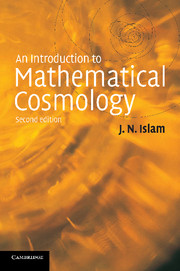Book contents
- Frontmatter
- Contents
- Preface to the first edition
- Preface to the second edition
- Dedication
- 1 Some basic concepts and an overview of cosmology
- 2 Introduction to general relativity
- 3 The Robertson–Walker metric
- 4 The Friedmann models
- 5 The Hubble constant and the deceleration parameter
- 6 Models with a cosmological constant
- 7 Singularities in cosmology
- 8 The early universe
- 9 The very early universe and inflation
- 10 Quantum cosmology
- 11 The distant future of the universe
- Appendix
- Bibliography
- Index
Appendix
Published online by Cambridge University Press: 03 February 2010
- Frontmatter
- Contents
- Preface to the first edition
- Preface to the second edition
- Dedication
- 1 Some basic concepts and an overview of cosmology
- 2 Introduction to general relativity
- 3 The Robertson–Walker metric
- 4 The Friedmann models
- 5 The Hubble constant and the deceleration parameter
- 6 Models with a cosmological constant
- 7 Singularities in cosmology
- 8 The early universe
- 9 The very early universe and inflation
- 10 Quantum cosmology
- 11 The distant future of the universe
- Appendix
- Bibliography
- Index
Summary
Introduction
In this appendix we consider topics some of which are extensions of material covered in the earlier chapters, and other additional ones which are not necessarily recent developments, but may have relevance for cosmological studies generally. We discuss both observational and theoretical matters.
Neutrino types
A significant discrepancy between theory based on the standard model of particle physics and observation of the flux of solar neutrinos on the surface of the Earth has been noticed for some years. In spite of much effort, an adequate explanation of this discrepancy has not been found.
As discussed in Section 8.8, the number of types of neutrino is of cosmological importance. Among relevant points to emerge at the 14th International Conference on Neutrino Physics and Astrophysics at CERN in 1990 was that there are three neutrino types unless the mass of the fourth one exceeds 45 GeV; the relic abundance of such a heavy neutrino is not sufficient to contribute to dark matter (Griest and Silk, 1990; Salati, 1990). These results come from LEP, the Large Electron Positron collider at CERN.
A large detector has been set up at Mount Ikenoyama in an active zinc mine in Japan, known as the Super-Kamiokande Detector (Kearns, Kajita and Totsuka, 1999). The original experiment was concerned with the detection of proton decay, and was set up at Kamioka, a mining town about 250 km from Tokyo.
- Type
- Chapter
- Information
- An Introduction to Mathematical Cosmology , pp. 220 - 237Publisher: Cambridge University PressPrint publication year: 2001

